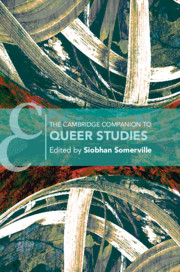Book contents
- The Cambridge Companion to Queer Studies
- The Cambridge Companion to Queer Studies
- Copyright page
- Dedication
- Contents
- Figures
- Contributors
- Acknowledgments
- Chronology
- Introduction
- Part I Genealogies
- Part II Confluences
- Chapter 3 Convergence, Dissymmetry, Duplicities
- Chapter 4 Transgender Studies, or How to Do Things with Trans*
- Chapter 5 Queer Indigenous Studies, or Thirza Cuthand’s Indigequeer Film
- Chapter 6 Queer Disability Studies
- Chapter 7 Queer Ecologies and Queer Environmentalisms
- Part III Representation
- Part IV Key Words
- Index
- Cambridge Companions to …
- References
Chapter 4 - Transgender Studies, or How to Do Things with Trans*
from Part II - Confluences
Published online by Cambridge University Press: 02 June 2020
- The Cambridge Companion to Queer Studies
- The Cambridge Companion to Queer Studies
- Copyright page
- Dedication
- Contents
- Figures
- Contributors
- Acknowledgments
- Chronology
- Introduction
- Part I Genealogies
- Part II Confluences
- Chapter 3 Convergence, Dissymmetry, Duplicities
- Chapter 4 Transgender Studies, or How to Do Things with Trans*
- Chapter 5 Queer Indigenous Studies, or Thirza Cuthand’s Indigequeer Film
- Chapter 6 Queer Disability Studies
- Chapter 7 Queer Ecologies and Queer Environmentalisms
- Part III Representation
- Part IV Key Words
- Index
- Cambridge Companions to …
- References
Summary
What is transgender studies, and what are its major methods? While the field itself is oriented against definitive answers to such questions, transgender studies does indeed possess a history and an emergent set of critical tools, both similar to and yet divergent from the more institutionally embraced field of queer studies. Drawing on Janet Halley’s early mapping of each field’s claims as well as Susan Stryker’s characterization of transgender studies as queer theory’s “evil twin,” this chapter explores the critical relation enacted between the two fields, tracing relevant points of congruence and tension between their methods. Both like and yet unlike queer studies, trans* studies points up queer theory’s limitations while inverting many of its major premises. Rather than envisioning the fields as opposites, however, this chapter seeks to clarify their relation as a fruitful paradox in which each discourse problematizes and yet enlivens the other’s claims. It then concludes by demonstrating some of trans* studies’ core methods through a close reading of John Carpenter’s The Thing (1982).
- Type
- Chapter
- Information
- The Cambridge Companion to Queer Studies , pp. 66 - 78Publisher: Cambridge University PressPrint publication year: 2020
References
Further Reading
- 6
- Cited by



